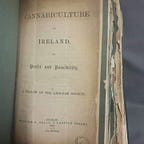Growing Hemp In West Cork In The 1960s
By Brian Houlihan
(Please consider becoming a patron to support the creation of more unique content)
Recently I discovered a report called the ‘West Cork resource survey’. This research is a comprehensive survey of the agricultural resources of the West Cork region. The research was undertaken by An Foras Taluntais (The Agricultural Institute) and first published in May 1963. It is worth noting that An Foras Taluntais was the predecessor to Teagasc which was established in 1988.
The survey was undertaken after the West Cork Development Association and other local organisations requested the assistance of An Foras Taluntais. The request was fueled by concerns over the low levels of agricultural development and the rate of depopulation in the region. Contained within the comprehensive report (over 300 pages) are a number of references to hemp and its potential for West Cork.
The survey states that “hemp is widely grown in countries where small farms and hand labour predominate”. It’s revealed the principal areas of cultivation in Europe are Italy, Yugoslavia, Spain, Romania and Poland. It’s suggested that “although native to a warmer climate than ours, hemp, like the potato, appears to be quite well adapted to the Irish climate.”
Interestingly the report references hemp experiments in Ireland which showed that “yields of 15 cwt. or more of fibre of excellent quality can be obtained here.” The potential financial benefits of hemp are highlighted when it’s revealed that “at present prices, an acre of this crop would give a return of approximately £135.”
It’s suggested that “because of the higher yield of fibre per acre from hemp, and the lower labour content” that if the hemp experiments continue to prove successful it “might prove more profitable than flax and therefore go into general cultivation in Ireland.”
Elsewhere in the report it’s argued that “hemp might be a better prospect than flax, but it would seem that either crop, properly grown, would be a valuable addition to the economy of the area.”
It’s argued that to make hemp growing competitive it would be best to start in a region where the conditions are most favourable. In this respect it’s suggested that “West Cork has two distinct advantages; there is the nucleus of a tradition in handling fibre crops, and the climate is amongst the mildest and most frost-free in the country.”
However, some of the disadvantages would be “the scarcity of first-class tillage land, and the degree of exposure” that exists in the region. It’s believed these factors would limit hemp's potential. Nonetheless, it is suggested that it should be possible to produce “about one thousand acres annually, which would represent the quantity imported into Northern Ireland annually.”
Elsewhere the report states that “If suitable retting and handling facilities could be provided West Cork would seem to be an appropriate place to introduce this crop on a commercial scale.” The report outlines the costs of setting up a hemp retting unit, which is estimated to be £50,000. The image below outlines the breakdown of the costs associated with the proposal.
Ultimately neither a hemp or flax industry was developed in the region (or elsewhere in the Republic) and arguably this occurred for a number of reasons. The Irish political mainstream moving from agrarian based economics to a foreign direct investment (and more urban) based economy, led by the likes of Seán Lemass and T. K. Whitaker, is significant.
The switch towards the importation of everyday goods and away from domestic production is worth considering. This trend was seen in most countries during this period and still exists today. The competition to hemp from cheaper foreign markets, particularly Asia, and the move towards synthetic products, where natural ones such were once used, also played a role.
One also cannot overlook the fact that the use of hemp generally was in decline before, during, and after this period. Aside from the countries that never restricted its use (France for example) hemp’s revival has only started in more recent decades. Since then we have seen hemp everywhere in Ireland from specialised hemp shops, supermarkets and cosmetic stores.
We at the Irish Hemp Society hope to be part of hemp’s wider revival in Ireland. 2017 should be an interesting year so keep an eye out for us.
Brian Houlihan is the curator of the Dublin Hemp Museum and regularly writes about hemp. Follow him on Twitter at @dubhempmuseum and @houlihanbrian. You can also find the museum on Facebook.
